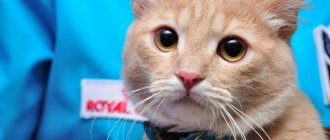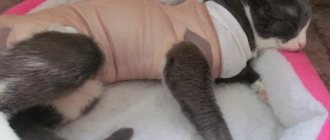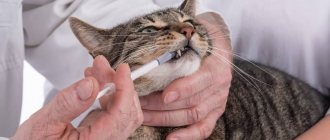Cat owners wash their pets not for their benefit, but for their own. Cats can swim, but they do not enjoy the procedure. They wash themselves several times a day. However, housewives still wash their cats. If he is dirty, wet himself or has an unpleasant odor.
But what to do with your pet after castration? It is known that the postoperative suture cannot be wetted. When can I bathe him to get rid of the unpleasant smell? This article reports about this.
Features of postoperative care for animals
Sterilization and castration must be approached responsibly. Even after minimal surgical intervention, the animal requires special care.
The recovery period lasts 7-14 days. For it to pass without complications, it is necessary:
- Put a special collar on your pet. The wounds will heal faster because the animal will not lick them.
- Immediately after a vasectomy or spay, place your pet on a warm surface at floor level. This is due to a lack of coordination after anesthesia.
- Make sure that the animal does not stay in a draft. Otherwise, kidney problems and the development of inflammatory processes are possible.
- Treat stitches and wounds with iodine or brilliant green twice a day. This is necessary to prevent infection.
- Keep the tray clean. After each trip to the toilet, the filler is changed. It is advisable to rinse the tray with boiling water.
During the recovery period, it is recommended to feed the cat with special canned food for recovery, for example Purina Veterinary Diets CN or Royal Canin Recovery Canine Feline. The diet contains easily digestible components, microelements, vitamins and minerals necessary for the body. After 2 weeks, you can start switching your pet to premium or super-premium dry food for neuters.
The health of cats depends on their mental state. After the stress experienced during the operation, animals need to be provided with physical and emotional rest. It is recommended to protect them from communication with other pets and children.
What should you do on the day of surgery?
When a cat returns home after a neutering procedure, owners should seek advice from their veterinarian regarding feeding, bathing, grooming and grooming. The advice provided by a specialist must be taken into account and followed in order to give the pet the opportunity to easily endure the recovery process, experience less pain and ensure rapid healing of the sutures.
If a cat is just beginning to recover from anesthesia, the owner needs to give the pet freedom of movement and minimize its stress. In the postoperative state, cold, drafts and heavy loads are contraindicated for the pet, so it must be placed in a spacious carrier. In winter, an ordinary plastic carrier needs to be insulated - put a warm bedding and a small heating pad on the bottom.
It is especially important to prevent hypothermia in cats of short-haired or hairless breeds, which are naturally sensitive to low temperatures.
It is contraindicated to carry a cat in your hands or carry it in a car without a carrier. It is impossible to predict in advance how cats will recover from anesthesia after sterilization, because even calm animals in a state of shock can begin to rush around the salon or show aggression. Therefore, the owner should buy or rent a special carrier in advance, in which the animal will come home without any problems.
The optimal position for your pet in a carrier is on its side. This position of the body will ensure the free release of vomit, which may appear in some animals as an adverse reaction to anesthesia. To prevent stitches from licking, on the day of surgery a cat collar, which has a round shape, is placed on the pet’s neck. The owner can make a cat collar with his own hands from scrap materials. You can learn how to make a collar for a cat using master classes posted on the Internet.
Upon arrival home, the cat can be left in the carrier until it recovers from the anesthesia. During this period of time, the owner will need to perform some manipulations:
- turn the cat over every half hour;
- periodically close your eyelids to prevent inflammation of the cornea due to dry eyes;
- give an anesthetic injection (if it was not given first at the veterinary clinic);
- prevent drafts in the room;
- cover the pet with a light cloth;
- If the cat is trembling after sterilization, you can place a heating pad nearby.
It is also necessary to check whether blood is oozing from the suture. Minor bruising and ichor discharge are acceptable, but if the owner notices heavy bleeding and notes that the cat's condition has worsened after sterilization, he should contact a veterinarian immediately.
Is it possible to wash a cat after castration?
If your pet needs to be washed, it is better to do this 2 days before surgery. After a vasectomy, this procedure should be performed no earlier than 2 months later. During this time, the skin is completely regenerated, and the animal will not feel the effects of surgery.
After anesthesia, the muscles are relaxed, so uncontrolled urination is possible. As a result, the cat may get dirty and become a source of unpleasant odor in the house. When the anesthesia wears off, the animal should wash itself with its tongue. If this does not happen, the pet can be bathed. However, washing should be postponed for 7-8 days. If you do this earlier, complications are possible:
- seam divergence;
- opening of a wound;
- bleeding;
- infection;
- suppuration.
Complications are difficult for the pet and threaten his life. If they occur, consultation with a veterinarian is necessary.
About the operation itself
Two types of operation are possible:
- Castration. It involves the removal of the testes or the cessation of their functioning.
- Sterilization. With this intervention, the testes remain in the body, while they continue to work and produce hormones.
Castration can be carried out using two methods:
- Bloody methods. They involve the removal of the testes and appendages using a surgical incision. The operation is performed under general anesthesia.
- Bloodless methods. With this technique, the testes remain in the scrotum, but the vessels and nerves of the spermatic cord are destroyed. Due to impaired blood supply and innervation, the testes atrophy on their own after some time.
Sterilization in cats is also called a vasectomy. With this intervention, the testes and spermatic cord are not touched, only the vas deferens is cut, so sperm do not enter the urinary canal during ejaculation, so the cat cannot fertilize the female. However, the testes continue to produce testosterone, which is why the pet behaves as before: marks corners, demands the cat, asks to go outside.
How do you know when your cat can be washed?
Your pet may not lick itself for several days after a vasectomy. This is due to poor health, wearing a special collar, and stress. Problems with the coat appear: it can become oily, take on the form of “icicles”, and in representatives of long-haired breeds mats often form. In this case, a pet that requires special care simply needs to be bathed.
The cat can be washed after 7 days if:
- wounds heal well;
- the cat is active and playful;
- the animal's appetite is normal;
- no bleeding;
- there is no inflammation in the scrotum area;
- trips to the toilet are regular and painless.
Before bathing, it is recommended to show the animal to a veterinarian. The doctor will conduct an examination and give recommendations.
Castration: why?
In order to avoid typical behavioral problems with an older cat, castration is performed - surgical removal of the gonad. As a result, the cat:
- Stops showing aggression;
- It becomes calmer;
- Starts to play (age does not affect activity);
- Stops leaving marks.
In most cases, castration does not cause any harm to the cat, which is why this method is popular. If the pet is completely healthy, then it quickly recovers from anesthesia. However, for some time it requires additional care.
What and how can you wash an operated cat?
Many people are interested in what method of bathing is suitable for a pet, including a neutered one, how long a cat can be washed after castration, and how this will affect its health.
It is recommended to wash a pet who has recently had a vasectomy without using shampoo and for no longer than 10 minutes. A towel is placed at the bottom of the bath so that the animal can stand comfortably. Warm clean water is used for washing.
While bathing, you should avoid the area that has undergone surgery. It is not recommended to water your pet from a shower, tap, etc. It is better to use a damp sponge and wipe the most contaminated areas with it. A small amount of water can be drained from the ladle if necessary.
As care products, you can use decoctions of calendula or chamomile. They do not require rinsing and promote disinfection and healing of wounds.
Wearing a collar and blanket
When the pet has completely recovered from the anesthesia, he will try to remove the protective collar. The owner must prevent this, since pity for the animal will ultimately lead to disastrous consequences - the cat will begin to lick the stitches, inflammation will appear, and in addition to wearing a collar for two to three weeks, the pet will be additionally prescribed a whole course of potent antibiotics that put a strain on the internal organs.
The cat will get used to the blanket in two to three days and will be able to eat and drink water normally with a protective collar around its neck. If the owner cannot understand why the cat does not eat after sterilization, then he needs to pay attention to the position of the bowl. It should stand at a certain height from the floor and have a slightly smaller size than the diameter of the collar on the pet’s neck. These conditions are necessary so that the cat can easily reach the food bowl and gain access to food.
Your veterinarian may recommend a bandage for your cat after sterilization, which will reduce stress and allow the sutures to heal quickly. A correctly used post-operative cat bandage will help the animal experience less pain when moving. It is indicated not only after the sterilization procedure, but also after any abdominal surgery in animals.
Special shampoos for washing
If your pet was sterilized during the day, and in the evening he got dirty and needs to be bathed, you can use dry shampoo. The product is applied only to the areas of contamination, rubbed in, and then combed out thoroughly. Wool does not need to be washed with water.
It is better to wash a cat after castration with shampoos for kittens. They are hypoallergenic and contain fewer chemical additives. Good shampoos are from manufacturers such as: Trixie, 8in1, Beaphar, VetExpert.
All information posted on the site is provided in accordance with the User Agreement and is not a direct instruction to action. We strongly recommend that before using any product, you must obtain a face-to-face consultation at an accredited veterinary clinic.
Important rules for owners
Additional recommendations that the owner of an operated cat must follow:
- If your pet used to walk outside, then during the week he is strictly prohibited from walking. So are active games. The main thing now is to preserve the postoperative sutures and prevent them from coming apart and becoming infected.
- Be sure to use an Elizabethan collar to limit licking of the operating area. You will have to wear it for at least a week. If your pet repeatedly tries to remove it, you should consult a veterinarian; you may have to use sedatives. When using them, the cat will almost always sleep.
- Some experts advise that in the first days, remove the litter from the toilet altogether and put shredded toilet paper in it (it is strictly forbidden to use newspapers for these purposes). This measure can prevent infection of the surgical suture and the canal itself.
- You should not bathe your pet for one to two weeks after surgery.
- During the first two days, the cat may experience pain. If the period of suffering drags on, this is an alarming sign; a hematoma or inflammation may develop. It is necessary to urgently consult a veterinarian.
In agreement with the surgeon, the following painkillers can be used in the first two days:
- Ketofen - in tablets or injections. Dosage 1 mg or 0.2 ml per 1 kg of cat weight.
- Ainil is a solution for subcutaneous administration (0.2 ml per 1 kg of weight).
- Previcox is a generic tablet drug. One dose is prescribed per 3 kg of animal weight.
The effect of one tablet or injection is designed for 12 hours, that is, analgesics cannot be given more than twice a day.
If after two days the pain continues, you should consult a surgeon.
How to properly wash a cat at home
The “cat washing” operation requires careful preparation of all participants.
Most cats have a very negative attitude towards the ablution procedure, especially if the owner has not bothered to teach the kitten to bathe from a young age.
Stages of the long journey (to wash the cat so that it does not kill you):
- Make sure your pet goes to the toilet (so that an unfortunate incident does not happen to him during bathing).
- Get an assistant (it’s best to bathe a cat together - someone should hold it and, if necessary, bandage bloody wounds).
- Comb your pet (wet tangles will subsequently be impossible to untangle and will have to be cut off, disfiguring the fur coat).
- Place the cat in the bathtub, first protecting the drain from hair with a strainer and placing a towel on the bottom.
- Water your furry prisoner from the shower, avoiding getting water into his ears (you can protect them with cotton swabs). Important: do not turn on the shower too much, otherwise the cat will get scared! The stream should be thin so that the sound of water is barely audible.
- Pour a special shampoo over your wet pet and lather it. Don't forget the tail. To prevent water from getting into the ears, you can put a disposable bath cap (regular, for people) on the cat.
- Rinse the cat thoroughly and swaddle it in a towel.
We suggest you familiarize yourself with Vomiting with blood or coffee grounds in cats
Some owners insist on soaping their pet twice, but this is not at all necessary. There is less stress for the cat (and the owner), and the fur is washed even during a single-phase bathing.
Particularly inventive owners place the pet not in an empty bath, but in one filled with 15–20 cm of warm water (about 40°C). Observations of the cat will show which option is preferable for him.
In the case of long-haired breeds, the bathing algorithm becomes somewhat more complicated. First, a degreasing paste is applied to the fattest parts of the cat's coat (collar, tail, behind the ears).
GOOP Degreaser paste
After washing off the paste, the animal is first washed with a degreasing shampoo, and then with a texturizer shampoo. Texturizer adds volume to wool.
If a cat is groomed before a show, after the texturizer it is also washed with a coloring shampoo. The final step is to apply balm to the coat and rinse it off.
But if you don’t want to do any of this, it’s enough to use only the paste and standard animal shampoo (as we wrote in the picture).
After keeping the cat in a towel for some time, you can dry the disheveled creature with a hairdryer using the cold setting.
If your cat is even more afraid of a hairdryer than of water, you need to change the towel to a dry one and dry the little one in the package.
After bathing, the pet will try to return the fur to its original appearance and will begin to lick itself feverishly.
How often can you wash your cat?
We've already established that allergy sufferers have to wash their cats weekly, but what about happier like-minded people who aren't affected by the dangerous FelD1 protein?
A short-haired cat, as was said, does not need to be washed at all; it will handle hygiene itself. But there are situations when even she can’t get away from washing.
If your freedom-loving beauty “walks on her own,” her bathing will become one of the mandatory points of the program. A traveler can pick up ticks and fleas from the street (special collars do not always help), and she can get dirty while exploring the surroundings.
A researcher wandering around the area around a dacha or private home is bathed approximately every two months.
But the handsome dogs, gifted by breeders with long hair, are in a different situation. We are announcing the entire list of cats that, sadly, need to be washed.
Which cats need to be washed?
This list can hardly be called complete: the ranks of four-legged animals are replenished from time to time with new breeds (breeders are not asleep).
With regular brushing and being “under house arrest,” it is enough to bathe a long-haired kitty once every three months.
Diet features
Veterinarians do not place much emphasis on changing the diet. During the operation, the digestive organs are not affected, so the pet can return to its usual food. Recommendations regarding when to feed a cat after sterilization depend on the pet's condition and behavior.
For the first time after surgery, you need to place a bowl of food in front of your pet when he becomes interested in food; you cannot force feed the animal.
In some cases, veterinarians recommend that the cat be given a light, low-fat diet based on easily digestible food for the first few days after surgery. This will reduce discomfort and prevent problems with the gastrointestinal tract.
Portions should be small. The food in the bowl should be fresh and have a pleasant smell in order to stimulate the appetite of an exhausted animal during the postoperative period. You can feed your cat high-quality natural food or use commercial holistic food.
The alarm should be sounded if the cat does not drink water after sterilization for 24 hours, refuses to eat on the day of surgery and the next day, and also if the pet vomits after every meal.
Because of their low metabolic rate, neutered cats must eat a quarter less food to maintain a healthy body weight than their healthy counterparts. Taking this into account, the owner will be able to correctly prepare a diet for the cat and dispel the myth that after the castration procedure all pets gain weight and become obese.
Should you wash your cat if you have allergies?
Some cat owners are too early to rejoice, while others should not rush and enthusiastically cross off periodic bathing of their pet from their list of must-dos.
There is a very good reason to give your cat a regular bath, even a short-haired one: allergies. Yours or someone in your household.
Allergy-free cats do not exist in nature, no matter what breeders say, trying to sell an adorable “hypoallergenic” kitten to people.
Every member of the cat family, without exception, produces the FelD1 glycoprotein. This insidious substance gets its name from the abbreviation of the Latin name for the domestic cat - Felis domesticus.
The animal’s sebaceous glands actively work, “charging” everything that the cat’s body is rich in with a dangerous allergen. These are saliva, dandruff, epithelium, sebum, fur, urine, excrement.
The common belief that hairless Sphynx cats do not cause allergies is just a myth. The Sphinx similarly enriches the interior with the products of its vital activity.
Washing your cat weekly will help reduce the number of allergens in the room. When bathing your pet, you need to thoroughly clean the neck: in this place there are many sebaceous glands, and the most allergens.
However, after a couple of days, the level of FelD1 is restored to its previous amount. In the period between baths, anti-allergic wipes (such as Allerpet) can help, which can be used to wipe the animal.
Spaying the female or neutering the male is another method to reduce FelD1 levels, but not eliminate it completely. By excluding the action of sex hormones from the cat’s metabolism, we reduce the production of glycoprotein, which is potentiated by them.
What to do if you have an allergy
The cat must be accustomed to an individual sleeping place, no matter how eager it is to share the bed with you. The contents of the tray must be removed immediately, without waiting for the moisture to evaporate and the solid particles to dry.
When can you wash your cat after sterilization?
Sterilization of a cat is not a very popular operation; sexual behavior does not change from tubal ligation.
In order not to hear the cat's screams during the period of heat, owners resort to castration, which is popularly mistakenly called sterilization when it comes to a female.
Castration of a cat is a cavity operation, more complex than castration of a cat. To prevent the cat from licking the stitches, a blanket is put on it, which is removed after two weeks, simultaneously with the removal of the stitches.
However, the condition of the wound must be monitored and washed with hydrogen peroxide daily. It is allowed to wash the cat a week after the sutures are removed and examined by a veterinarian.
The need to wash your cat before this date:
- Dried blood or ichor in the incision area.
- Contamination with products of urination or defecation.
Blood in the suture area is removed with hydrogen peroxide, chlorhexidine or alcohol. To eliminate the smell of urine, rub potato starch into the wool.
The results of defecation are washed off with warm water or saline. No moisture is left on the wool.
If it is necessary to bathe a cat two weeks after sterilization, the standard algorithm undergoes changes. Instead of a shower, use a mug of warm water.
The bath is not filled: the animal is placed on a towel at the bottom. The seam of the bathed and dried animal is treated with brilliant green.
Help for your pet











